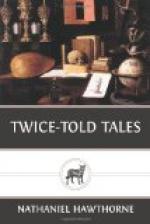THE MAYPOLE OF MERRY MOUNT.
There is an admirable foundation for a philosophic romance in the curious history of the early settlement of Mount Wollaston, or Merry Mount. In the slight sketch here attempted the facts recorded on the grave pages of our New England annalists have wrought themselves almost spontaneously into a sort of allegory. The masques, mummeries and festive customs described in the text are in accordance with the manners of the age. Authority on these points may be found in Strutt’s Book of English Sports and Pastimes.
Bright were the days at Merry Mount when the Maypole was the banner-staff of that gay colony. They who reared it, should their banner be triumphant, were to pour sunshine over New England’s rugged hills and scatter flower-seeds throughout the soil. Jollity and gloom were contending for an empire. Midsummer eve had come, bringing deep verdure to the forest, and roses in her lap of a more vivid hue than the tender buds of spring. But May, or her mirthful spirit, dwelt all the year round at Merry Mount, sporting with the summer months and revelling with autumn and basking in the glow of winter’s fireside. Through a world of toil and care she flitted with a dream-like smile, and came hither to find a home among the lightsome hearts of Merry Mount.
Never had the Maypole been so gayly decked as at sunset on Midsummer eve. This venerated emblem was a pine tree which had preserved the slender grace of youth, while it equalled the loftiest height of the old wood-monarchs. From its top streamed a silken banner colored like the rainbow. Down nearly to the ground the pole was dressed with birchen boughs, and others of the liveliest green, and some with silvery leaves fastened by ribbons that fluttered in fantastic knots of twenty different colors, but no sad ones. Garden-flowers and blossoms of the wilderness laughed gladly forth amid the verdure, so fresh and dewy that they must have grown by magic on that happy pine tree. Where this green and flowery splendor terminated the shaft of the Maypole was stained with the seven brilliant hues of the banner at its top. On the lowest green bough hung an abundant wreath of roses—some that had been gathered in the sunniest spots of the forest, and others, of still richer blush, which the colonists had reared from English seed. O people of the Golden Age, the chief of your husbandry was to raise flowers!
But what was the wild throng that stood hand in hand about the Maypole? It could not be that the fauns and nymphs, when driven from their classic groves and homes of ancient fable, had sought refuge, as all the persecuted did, in the fresh woods of the West. These were Gothic monsters, though perhaps of Grecian ancestry. On the shoulders of a comely youth uprose the head and branching antlers of a stag; a second, human in all other points, had the grim visage




